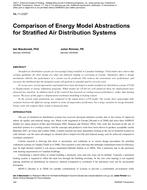Description
Stratified air distribution systems are increasingly being installed in Canadian buildings. Field studies have shown that existing guidelines for their design are often not followed leading to oversizing of systems. Simulation offers a design mechanism whereby the performance of a system can be predicted. This reduces the uncertainty over performance and increases the likelihood that the designed system will perform as intended and be correctly sized.
In recent years several approaches and models have been developed to model stratified air distribution systems (UFAD or Displacement) in energy simulation programs. While models for UFAD are well advanced those for displacement have attracted less attention. In addition much of the research has focussed on cooling season performance, rather than heating season. The focus of this paper is displacement ventilation modelling in heating season.
In the current study predictions are compared to the output from a CFD model. The results show surprisingly little variation between the different energy models in terms of temperature predictions, but a large variation in energy demands.
Future work will compare these results to measured data.
Citation: ASHRAE Conference Papers, Montreal, QC
Product Details
- Published:
- 2011
- Number of Pages:
- 8
- File Size:
- 1 file , 900 KB
- Product Code(s):
- D-ML-11-C027




